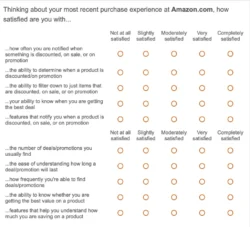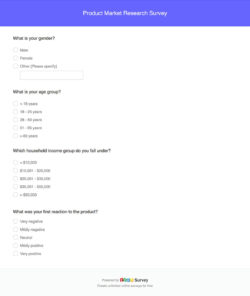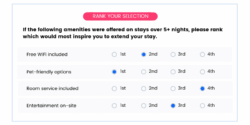Understanding your audience is one of the most powerful tools for any business, researcher, or organization. Whether you are launching a new product, assessing customer satisfaction, or conducting academic research, knowing who you are speaking to, or who you are serving, makes all the difference. Demographic questions are the backbone of this understanding, providing essential insights into the characteristics of your survey respondents.
They help you segment your data, identify trends, and tailor your strategies more effectively. In this guide, we will explore why these questions are crucial, how to best phrase them, and provide a comprehensive demographic questions sample survey template to get you started.
Why Are Demographic Questions So Crucial for Your Survey
Demographic questions are far more than just standard survey additions; they are fundamental to extracting meaningful and actionable insights from your data. Imagine analyzing survey results without any context about who provided the answers. You might see that 70 percent of respondents love your new feature, but without demographic data, you would not know if that 70 percent is predominantly young adults, elderly individuals, or people from a specific geographic region. This context is vital for making informed decisions.
These questions allow you to segment your audience and identify specific trends within different groups. For instance, you might discover that while overall satisfaction is high, respondents within a certain age bracket or income level have particular concerns. This level of granularity enables you to fine-tune your products, services, or communication strategies to better meet the needs of various segments. It moves you beyond generic assumptions to data-driven understanding.
Furthermore, including demographic questions helps ensure that your survey results are representative of your target population. By collecting data on various demographics, you can check if your sample accurately reflects the diversity of the group you are studying. This helps to validate your findings and ensures that your conclusions are applicable to a broader context. It is about painting a complete picture, not just a partial sketch.
Ultimately, well-designed demographic questions empower you to avoid assumptions and develop more empathetic and effective solutions. They provide the necessary context to understand why people think or act the way they do, linking their opinions to their life circumstances. This deeper understanding is invaluable for everything from product development to policy-making, fostering a more targeted and impactful approach.
Key Demographic Categories to Consider
When building your demographic questions sample survey template, think about the categories that are most relevant to your research objectives. Not every survey needs every category, but these are common and highly informative:
- Age: Often collected in ranges to protect privacy and simplify analysis.
- Gender Identity: Providing inclusive options beyond a binary choice is crucial today.
- Location: Can range from country and state to zip code, depending on specificity needed.
- Education Level: Helps understand a respondent’s background and potential access to information.
- Income Level: Typically collected in ranges to maintain anonymity while providing economic insight.
- Employment Status: Understanding their current work situation (e.g., employed, student, retired).
- Marital Status: Can sometimes influence purchasing habits or lifestyle choices.
- Ethnicity/Race: Important for diversity analysis and ensuring equitable representation.
Crafting Your Demographic Questions: Best Practices and a Sample Template
Designing effective demographic questions requires careful thought to ensure clarity, sensitivity, and relevance. The goal is to gather the necessary data without making respondents feel uncomfortable or intruded upon. Start by considering what information is truly essential for your analysis. Including too many demographic questions can lead to survey fatigue and a higher dropout rate, so prioritize based on your research goals. Keep your questions concise and easy to understand, avoiding jargon or ambiguous phrasing.
Sensitivity is paramount, especially when dealing with personal information. For questions about income, age, or gender, it is often best to use ranges or categories rather than asking for precise figures. For example, instead of asking for an exact birthdate, you might offer age brackets like "18-24," "25-34," and so on. Similarly, for gender identity, provide inclusive options such as "Female," "Male," "Non-binary," "Prefer to self-describe," and "Prefer not to say." This approach not only respects privacy but also makes respondents more likely to complete the survey honestly.
Think about the format of your questions. Multiple-choice questions with mutually exclusive and exhaustive options are generally preferred for demographic data, as they simplify data collection and analysis. Ensure that every possible answer is covered and that respondents can only select one option (unless the question specifically allows for multiple selections, like "What languages do you speak?"). Including a "Prefer not to say" or "Other (please specify)" option can also be very helpful for inclusivity.
Here is a conceptual demographic questions sample survey template, illustrating the types of questions and phrasing you might use. Remember to adapt these to your specific context and survey platform capabilities. The aim is to create a seamless experience for the respondent while gathering robust data that informs your understanding of their background and characteristics. This structured approach helps ensure consistency across responses and simplifies the analytical process later on.
- **Age:** “Which of the following age groups applies to you?” (e.g., Under 18, 18-24, 25-34, 35-44, 45-54, 55-64, 65 or older, Prefer not to say)
- **Gender Identity:** “What is your gender identity?” (e.g., Female, Male, Non-binary, Prefer to self-describe: ___, Prefer not to say)
- **Current Employment Status:** “Which of the following best describes your current employment status?” (e.g., Employed full-time, Employed part-time, Self-employed, Student, Unemployed looking for work, Unemployed not looking for work, Retired, Prefer not to say)
- **Highest Level of Education Completed:** “What is the highest level of education you have completed?” (e.g., High School Diploma or GED, Some College/Associate’s Degree, Bachelor’s Degree, Master’s Degree, Doctorate or Professional Degree, Prefer not to say)
- **Annual Household Income:** “What is your approximate annual household income before taxes?” (e.g., Less than $25,000, $25,000 – $49,999, $50,000 – $74,999, $75,000 – $99,999, $100,000 – $149,999, $150,000 or more, Prefer not to say)
Thoughtfully designed demographic questions are truly indispensable for any survey aiming to yield deep and meaningful insights. They transform raw data into a rich narrative, allowing you to segment your audience, understand their unique needs, and recognize the factors that influence their perspectives and behaviors. By meticulously selecting and phrasing these questions, you lay a strong foundation for robust analysis and actionable findings.
Ultimately, the power of a well-crafted survey lies in its ability to inform decision-making with precision. Leveraging a solid demographic questions sample survey template ensures that you are collecting the right information from the right people, empowering you to make strategic choices that resonate deeply with your target audience and drive significant impact.


